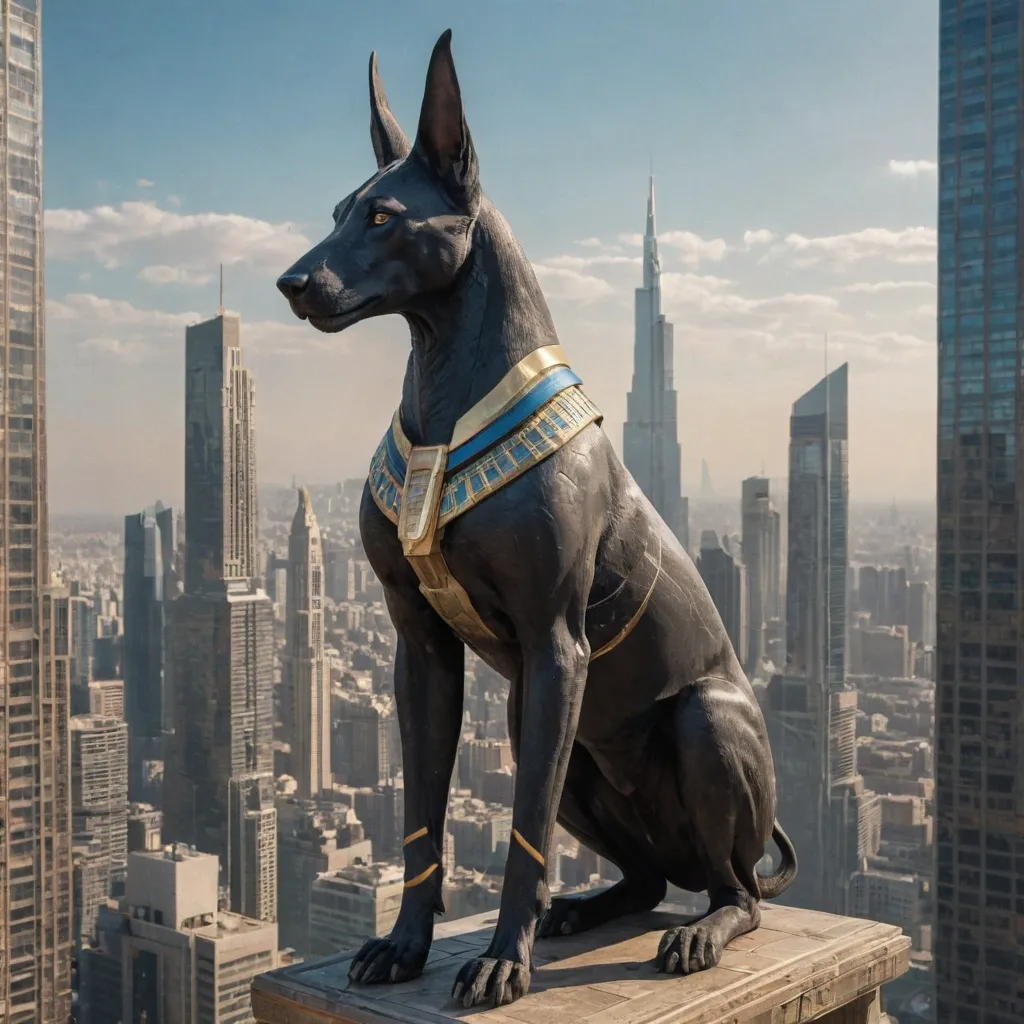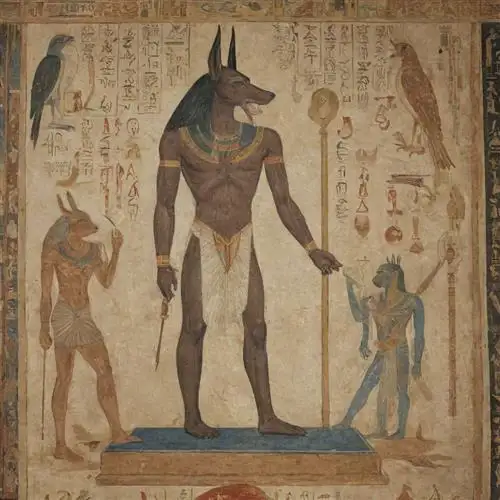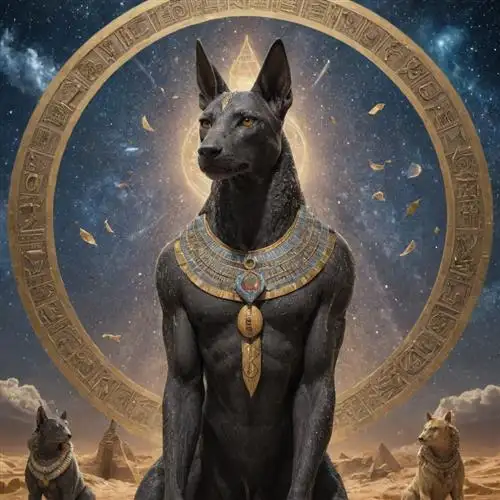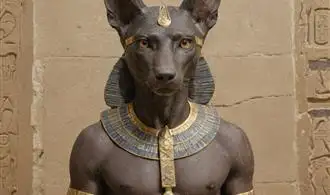
Who is Anubis the Egyptian God
Anubis, the enigmatic Egyptian deity, has long captivated the minds of scholars and enthusiasts alike. As the god associated with the afterlife, Anubis played a pivotal role in the ancient Egyptian belief system, guiding the deceased through the complex and mystical journey of the afterlife. To truly understand Anubis and his significance, we must delve deeper into his origins, attributes, and the profound influence he wielded over the ancient Egyptian civilization.
Anubis, often depicted with the head of a jackal or a black dog, was one of the earliest and most important deities in the Egyptian pantheon. He was revered as the god of embalming, the protector of graves, and the guardian of the dead. Anubis's primary role was to oversee the crucial process of mummification, ensuring the preservation of the deceased's physical form and their successful transition to the afterlife.
One of the most captivating aspects of Anubis's mythology is his role in the weighing of the heart ceremony, a pivotal event in the ancient Egyptian concept of the afterlife. During this ceremony, the deceased's heart was weighed against the feather of truth, representing the morality and righteousness of the individual. FOMO? Anubis Holds the Key to the Afterlife This ritual was overseen by Anubis, who would guide the soul through the underworld and determine its fate based on the outcome of the heart weighing.
Anubis's iconography and symbolism were deeply intertwined with the ancient Egyptian belief in the afterlife. The jackal-headed god was often depicted holding the ankh, a symbol of life, and the was scepter, a symbol of power and authority. These iconographic elements reinforced Anubis's role as the gatekeeper and protector of the dead, ensuring their safe passage to the afterworld.
Beyond his primary role in the afterlife, Anubis was also associated with other important aspects of ancient Egyptian culture. He was believed to be the inventor of embalming techniques, and his temple at Abydos was a renowned center of funerary rituals and pilgrimages. Anubis's influence extended to the realm of the living as well, as he was sometimes invoked for protection and guidance in the mortal world.
The Role of Anubis in the Afterlife
The Role of Anubis in the Afterlife is a complex and fascinating aspect of ancient Egyptian mythology. Anubis, the jackal-headed deity, was responsible for guiding the souls of the deceased through the afterlife and overseeing the process of mummification and the weighing of the heart ceremony. This iconic figure played a crucial role in the Egyptian belief system and their understanding of the journey into the afterlife.
Anubis was believed to be the patron of the embalming process, ensuring the proper preservation of the deceased's body. This was crucial as the Egyptians believed that the physical form was necessary for the soul's journey into the afterlife. Anubis would oversee the intricate process of mummification, ensuring the body was prepared for its eternal rest.
One of the most significant roles of Anubis was in the weighing of the heart ceremony, a pivotal moment in the Egyptian afterlife. This ritual involved the deceased's heart being weighed against the feather of truth, representing the person's morality and worthiness to enter the afterlife. Anubis was responsible for overseeing this process, ensuring the accuracy and fairness of the judgement. If the heart was found to be heavy with sin, the soul would be devoured by the fearsome Ammit, a devouring creature with the head of a crocodile, the body of a lion, and the hindquarters of a hippopotamus.
Anubis was also believed to guide the souls of the deceased through the treacherous underworld, known as the Duat. This journey was filled with challenges and obstacles, and Anubis was seen as a protector and guide, ensuring the soul's safe passage to the afterlife. He would help the deceased navigate the various gates and chambers of the Duat, guiding them towards their ultimate destination.
Anubis and the Mummification Process
Anubis, the jackal-headed Egyptian god, played a pivotal role in the mummification process, which was a crucial aspect of ancient Egyptian beliefs about the afterlife. As the god of embalming and guardian of the dead, Anubis oversaw the intricate and meticulous process of preparing the deceased for their journey into the next world.
The mummification process was a complex and multi-step procedure that aimed to preserve the body and ensure the deceased's successful transition to the afterlife. Anubis was responsible for guiding the embalmers through each stage of this process, which typically took 70 days to complete.
The first step involved the removal of the brain and internal organs, which were then placed in canopic jars, each guarded by a different god. Anubis would oversee the removal of the brain through the nose, a delicate procedure that required great skill and precision.
Next, the body would be submerged in a salt-based solution, which helped to dry out the tissues and prevent decomposition. Anubis would ensure that the body was properly positioned and that the salt solution was maintained at the correct concentration throughout this process.After the body had been dried, Anubis would then oversee the wrapping of the body in linen bandages, a process known as mummification. The embalmers would carefully wrap the body, leaving small openings for the eyes, mouth, and nose, to allow the deceased to breathe and communicate in the afterlife.
Throughout the mummification process, Anubis played a crucial role, ensuring that each step was carried out correctly and that the deceased was properly prepared for their journey into the afterlife. His presence and guidance were essential to the successful transition of the soul from the physical world to the spiritual realm.
Symbolism and Iconography of Anubis
Anubis, the jackal-headed deity of ancient Egyptian mythology, is a figure of immense symbolic significance. His iconography and symbolism are deeply intertwined with the ancient Egyptian understanding of the afterlife and the journey of the soul. As the god of embalming and the protector of the dead, Anubis played a crucial role in the rituals and beliefs surrounding death and the transition to the afterworld.
One of the most recognizable aspects of Anubis' symbolism is his jackal-like head, which represents his association with the jackal, a scavenger animal often found near the entrances to ancient Egyptian necropolises. This physical attribute is deeply symbolic, as the jackal was believed to guide the souls of the deceased to the afterlife and to guard the tombs and cemeteries where the dead were laid to rest.
The black color of Anubis' skin is also highly significant, as it represents the color of the fertile soil of the Nile River, which was essential for the regeneration of life. In this way, Anubis is linked to the cycle of life, death, and rebirth, serving as a bridge between the mortal world and the afterlife.
Another important aspect of Anubis' iconography is his role as the guardian of the mummification process. As the god of embalming, Anubis was believed to oversee the meticulous process of preparing the deceased for their journey to the afterlife. This involved the careful removal of the internal organs, the preservation of the body, and the wrapping of the mummy in linen bandages.
Anubis' role in the afterlife is equally significant, as he is depicted as the overseer of the weighing of the heart ceremony, a crucial step in the journey of the soul. In this ritual, the heart of the deceased was weighed against the feather of truth, and if the heart was found to be pure, the soul would be allowed to pass into the afterlife. The Unusual Insight Anubis Holds for the Living further explores the deeper significance of this ritual and its implications for the living.
Anubis in Modern Popular Culture
Anubis, the enigmatic Egyptian deity associated with death, the afterlife, and mummification, has captured the imagination of modern popular culture. From films and television shows to video games and comic books, this jackal-headed god has transcended the confines of ancient mythology and found a place in the contemporary zeitgeist.
One of the most prominent representations of Anubis in modern media is in the realm of cinema. The character has appeared in various blockbuster films, including "The Mummy" franchise, where he is often depicted as a powerful and intimidating figure guarding the gates of the underworld. These depictions have helped to cement Anubis' status as a recognizable symbol of ancient Egyptian mysticism and the afterlife.
Beyond the silver screen, Anubis has also found a home in the ever-evolving world of video games. In titles such as "Assassin's Creed: Origins" and "Smite," players can interact with Anubis, utilizing his abilities and leveraging his connection to the underworld to navigate the game's narrative and mechanics. These virtual interpretations of the deity have helped to introduce Anubis to a younger generation of enthusiasts, sparking their interest in ancient Egyptian mythology.
In the realm of comic books and graphic novels, Anubis has also been the subject of numerous adaptations. From Marvel's "Moon Knight" to the independent series "Anubis: Dog of Death," these visual storytelling mediums have explored the complexities of the deity's role, often blending ancient Egyptian lore with modern sensibilities. These depictions have not only entertained readers but also serve as a means of preserving and disseminating the rich cultural heritage associated with Anubis.
Beyond the traditional media, Anubis has also found a place in various subcultures and online communities. From occult and esoteric circles to Egyptology enthusiasts, the deity's symbolism and mystique continue to captivate audiences, leading to the creation of unique interpretations and representations. These diverse perspectives on Anubis have helped to ensure the enduring relevance of this ancient Egyptian icon in the modern world.
















